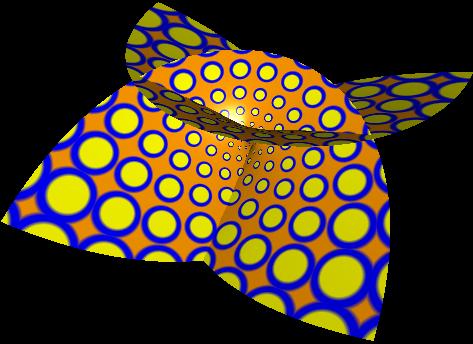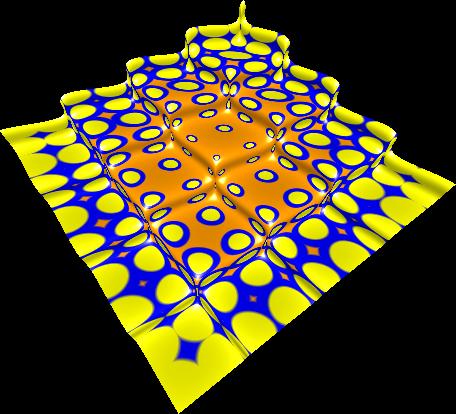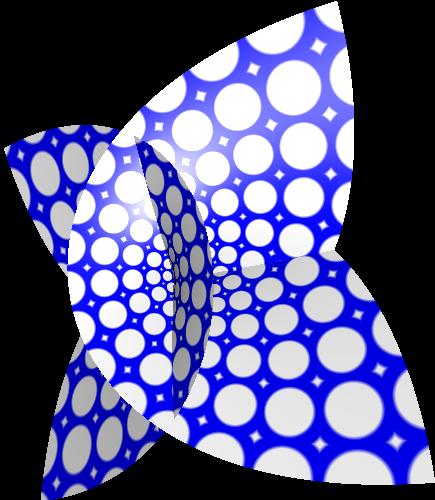
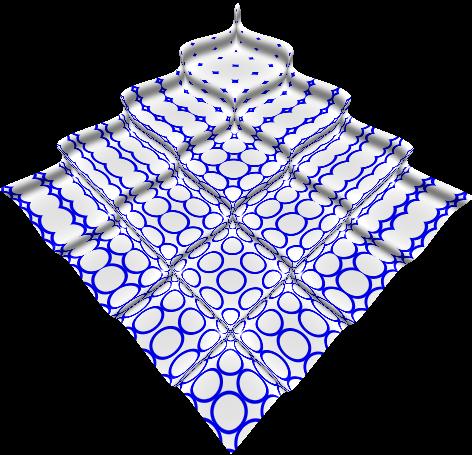
figure: A ring pattern on two surfaces. The size of a given ring is modulated by the magnitude
of the partial derivatives with respect to the surface parameters. To learn more about the
windmill or the qubert surfaces, follow the links.


figure: A ring pattern on two surfaces. The size of a given ring
is modulated by the magnitude
of the partial derivatives with respect to the surface parameters.
To learn more about the
windmill or the qubert
surfaces, follow the links.
The assignment was to make a procedural
shader. I decided to implement
mine through the recently presented Ashli Gl Viewer for
the ATI 9700 card.
This Renderman implementation offered advantages over
other methods, yet
it's incompleteness caused a lot of needless delay.
On this web page, I will
discuss first, my shaders, and then my experiences with
the Ashli Viewer.
Shader 1: rings, and rings-qub
These shaders started with a ring shader
on Steve May's RmanNotes
website. I wanted the rings on the surface to be
modified according to local
surface properties.
The first part is the creation of
the rings themselves. The texture
coordinates s and t are known at a point. There
are two radii to the rings,
the inside and outside. We pick regularly spaced
(in s and t) points to be the
centers of the rings, and then color the surface blue
if the (s, t) lie within the
two radii of one such center.
The second parts of the two shaders
make the assumption of either of
the two surfaces above. I found that the Du, Dv
operations are not
supported in the Ashli Viewer. In that I know the
parametric functions that
are the surfaces, I can easily compute the derivatives
with respect to s,t at a
particular texture (s,t) point. I then use this
number to modulate the radius
for the rings. Thus, the rings get larger as the
derivatives get larger.
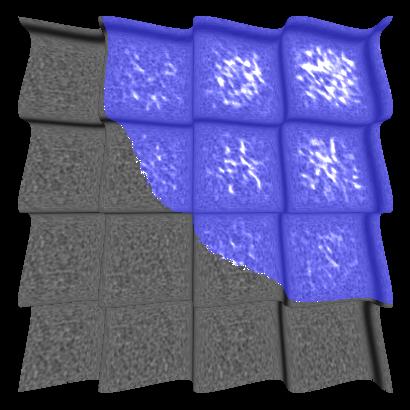
Shader 2: fallingwater
This shader simulates water flowing
radially over a surface, and also
modifies the flow with respect to local surface geometry.
I start by putting
sticky noise on the surface--sticky meaning noise that
is dependent on the
local texture coordinates, so that movement of the object
doesn't change the
pattern. The surface looks made of tiny stones
here. Next, I use (s,t) to
determine how far from a corner of the surface (s,t =
-5 in my case) is the
current point. If this distance is smaller than
a time-proportional number, I
do several things. First I add blue to the color
at that point and use time-
dependent noise to modify the normal for specular and
diffuse
calculations.
Second, if the point is within a region along the current
border of the water,
noise is added to the color to make it look like the
water is being broden up
by the small stones.
An additional computation based on
local geometry is done to the original
distance for better look and realism. The differentials
of the surface with
respect to the s and t surface parameters in the z (down)
direction are
computed. A number that is proportional to the
downward orientation of
the surface at a point, or the magnitude of these partials,
is added to the
original distance. Thus if the point is in a downward
sloping area, the
distance computed is big enough to render the point in
the water when it
otherwise might not be.
Overall:
Looking over the web, it is obvious
that some people really dig
procedural shaders and modeling. It is high on
my list of hobbies if I ever
have time. For this assignment, I would like to
have had more time on the
cool creative side, but it would hard to compete with
some of the obsessed
inspired people out there.
The Ashli Viewer is not a product,
so I should not have actually tried to
to use it without the source code at my disposal.
Many standard
Renderman functions are missing that would have proved
useful. As well,
the delay caused by incorrect implementation would have
been shorter.
However, a real-time Renderman implementation is worthy
goal. It was
very convenient to make small chenges and watch them
happen in real
time.
